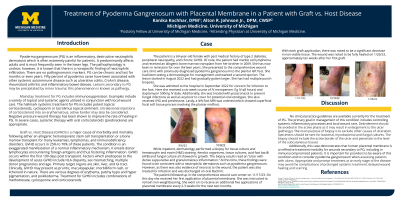Case Series/Study
(CS-086) Treatment of Pyoderma Gangrenosum with Amniotic Grafting: A Case Study

Alton Johnson, DPM, DABPM, FACPM, FASPS, CWSP – Clinical Assistant Professor, Metabolism, Endocrinology and Diabetes, University of Michigan
Introduction: Pyoderma gangrenosum (PG) is a systemic disease which causes painful, inflammatory ulcerations. The pathophysiology is unknown and currently no gold standard treatment exists for this condition.
Methods: This case describes the clinical course of a 69-year-old female with chronic graft versus host disease. This patient was treated for a non-healing plantar left foot wound of approximately four months duration.
Results: A wound biopsy revealed dense suppurative and granulomatous inflammation. As the patient’s wound demonstrated minimal improvement with local wound care, IV antibiotics, oral steroids, antifungal and antiviral therapy, pyoderma gangrenosum was identified as a diagnosis of exclusion. The patient received treatment with a placental membrane skin substitute. The wound measurements were recorded and photographed at each encounter. Complete healing was demonstrated after five applications between November 2022 and January 2023.
Discussion: The primary goal in management of pyoderma gangrenosum includes controlling systemic inflammatory processes and local wound care, however no clinical practice guidelines are available at this time. This case demonstrates that human placental membrane is an effective treatment modality for wounds secondary to pyoderma gangrenosum, including in immunocompromised patients.
Trademarked Items:
References:
Methods: This case describes the clinical course of a 69-year-old female with chronic graft versus host disease. This patient was treated for a non-healing plantar left foot wound of approximately four months duration.
Results: A wound biopsy revealed dense suppurative and granulomatous inflammation. As the patient’s wound demonstrated minimal improvement with local wound care, IV antibiotics, oral steroids, antifungal and antiviral therapy, pyoderma gangrenosum was identified as a diagnosis of exclusion. The patient received treatment with a placental membrane skin substitute. The wound measurements were recorded and photographed at each encounter. Complete healing was demonstrated after five applications between November 2022 and January 2023.
Discussion: The primary goal in management of pyoderma gangrenosum includes controlling systemic inflammatory processes and local wound care, however no clinical practice guidelines are available at this time. This case demonstrates that human placental membrane is an effective treatment modality for wounds secondary to pyoderma gangrenosum, including in immunocompromised patients.
Trademarked Items:
References:

.png)